TL;DR
Contemporary Amperex Technology (CATL), a breakout PRC (People’s Republic of China) battery company, has taken the world of clean energy by storm in the last decade. Founded in 2011, CATL has now become the world’s 3rd largest manufacturer of lithium-ion batteries. Recently, CATL claimed to have achieved the astounding milestone of a million mile battery (a battery that can be recharged and used for up to a million miles driven); an achievement no American, South Korean or Japanese battery maker has yet achieved. CATL stands as a testament to the formidable powers of PRC companies to do scientific innovation at scale.
A Brief History of CATL
Before founding CATL, Robin Zeng founded Amperex Technology Limited ATL in 1999. ATL is now a majority owned subsidiary of Japanese firm TDK. Robin Zeng earned his doctorate at the Institute of Physics at the Chinese Academy of Sciences and originally hails from Ningde in Fujian province. After finishing his PhD, he worked for a state shipbuilding corporation (likely a subsidiary of CSSC), before founding ATL in 1999 in Hong Kong. CATL was spun out of ATL in 2011; ATL started out owning 15% of CATL but liquidated that ownership in 2015 (source).
CATL benefited from strong PRC governmental subsidies for the battery manufacturing ecosystem starting in 2012 (source). CATL used its startup funding to establish large manufacturing facilities in Ningde (see photographs below). The combination of governmental tailwinds and manufacturing prowess helped accelerate CATL’s dizzying growth. In a matter of just years,
CATL succeeded in overtaking the venerable LG Chem in lithium ion manufacturing. CATL has expanded dramatically overseas as well with offices in Sweden, Germany, and France among others.


A number of European manufacturers have signed deals with CATL. French automaker PSA Group signed a deal in 2017 with CATL to order batteries (source), and
BMW announced a deal in 2018 to buy $4.7 billion of batteries from CATL (source). European firms have become hesitant to invest large funds into battery manufacturing firms which could potentially be undercut by CATL or other Asian manufacturers (source). CATL has invested back into the European ecosystem as well; for example, CATL purchased a 2.2% stake in Finnish Valmet Automative in 2017 (source).
CATL has made inroads into the South Korean and Japanese markets. Hyundai signed a deal with CATL in 2017 to source batteries (source). Honda has signed a deal to partner with CATL until 2027 (source). These deals are especially notable given that LG Chem and Panasonic are domestic battery giants in South Korea and Japan respectively. CATL’s ability to win deals in its competitors’ backyards is a powerful sign for its continued growth.
In 2018, CATL listed itself on the Shenzhen stock exchange (source) and quickly achieved a market cap of $12.3 billion shortly after (source). As the chart below shows, CATL has continued to do well on the Shenzhen exchange and has a market cap today of CNY 864 billion ($133 billion). CATL’s dramatic success has made its founder Robin Zeng one of the PRC’s richest men, with an estimated fortune of $32.9 billion as of April 2021 (source).

Recently, CATL achieved the powerful milestone of a 1 million mile battery, a battery that will last for 1 million miles before it can no longer be recharged, a technical feat which has drawn eyes globally (source 1) (source 2). CATL has signed a deal to supply these batteries to Tesla (source). At the time of writing, CATL is the only battery maker in the world which has claimed a million mile battery offering, with the only competitors in university labs (source).
We will try to tease apart the factors underlying CATL’s astonishing rise in the next few sections.
Bootstrapped Start
CATL got its start as a spin-out from the previously established ATL. As a result, though CATL itself is only a decade old, when counting its ancestry as part of ATL, it may be more accurate to view CATL as a 22 year old company. CATL was able to hit the ground running after its spinout and then leverage strong PRC governmental subsidies starting from 2012 onwards (source). The combination of existing business expertise along with a favorable governmental funding ecosystem has helped fuel CATL’s dizzying ascent.
Robin Zeng’s background as a domestically trained PRC PhD founder (as opposed to a foreign trained founder) may have given him an edge working with the PRC ecosystem. It’s possible that Zeng’s success may drive more PRC nationals to do their PhDs domestically rather than seeking overseas training. In the long run, the growth of PRC research institutions may weaken the global standing of American research institutions.
Overseas Talent Recruiting
CATL has leveraged the Thousand Talents Program to bring in a foreign expert and the Fujian Province 100 Talents Program to build a strong internal research program. The Thousand Talents program has proven a powerful vector for the PRC to bring in overseas talent of Chinese origin into PRC companies and has enabled CATLd to build a world-class research team able to outcompete more established teams from around the global ecosystem. If CATL’s 1 million mile battery claims hold up, CATL may well have succeeded in lapping American, South Korean, and Japanese battery manufacturers. The US needs a strategy to counter the Thousand Talents programs to prevent PRC brain draining of US talent.
Fujian and Provincial Competition
CATL is headquartered in Ningde, in the Fujian province. While Ningde is a major city with a population of nearly 3 million (source), it is not in the same tier as megacities like Shanghai or Shenzhen. One of the key drivers of innovation in the PRC is competition amongst provinces, allowing for a version of the intrastate competition that has proved a powerful driver of American excellence. CATL in particular has taken advantage of the Fujian Province 100 talents program to help bootstrap its growth. CATL was likely able to benefit from strong provincial support to obtain land and build its large domestic factories.


Discussion
CATL shows the ability of the PRC ecosystem to spawn innovative world-class deep tech startups. CATL provides a sign that the PRC ecosystem is now able to compete (and even out-compete) the American innovation ecosystem on critically important geopolitical challenges. The million mile battery, if successfully delivered, could accelerate global adoption of electric cars. At the same time, CATL strengthens the PRC position in clean energy and stands to give it a powerful advantage in geopolitics. As we have learned with rare earth metals, the PRC will not hesitate to use manufacturing leverage for geopolitical advantage. The emergence of companies like CATL raises a considerable challenge to the US, which needs to create the environment for American companies to outcompete PRC champions like CATL.
CATL stands as proof that PRC companies aren’t just fast-followers but strong innovators in deep tech. American companies should actively seek to learn lessons from the examples of their PRC counterparts. In a long strategic competition with the PRC, copying successful strategies will be as important as inventing new techniques.
Highlights for the Week
https://twitter.com/cHHillee/status/1386541907950465028: Huawei has trained a 200 billion parameter language model on Huawei chips and the PRC Mindspore framework. This is a powerful testament to the maturity of the PRC AI stack and a testament to its near parity with American tech giant AI stacks.
Feedback and Comments
Thank you for reading our subscriber-only newsletter! We’re still figuring out the rhythm for these posts, so if you have feedback on changes you’d like to see, please send them over to bharath@deepforestsci.com! If you’d like to see more financial analysis, or more technical analysis, or deeper dives into a particular industry let me know and I’ll see what we can do.
About
Deep Into the Forest is a newsletter by Deep Forest Sciences, Inc. We’re a deep tech R&D company specializing in the use of AI for deep tech development. We do technical consulting and joint development partnerships with deep tech firms. Get in touch with us at partnerships@deepforestsci.com! We’re always welcome to new ideas!
Credits
Author: Bharath Ramsundar, Ph.D.
Editor: Sandya Subramanian



